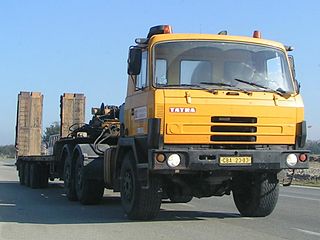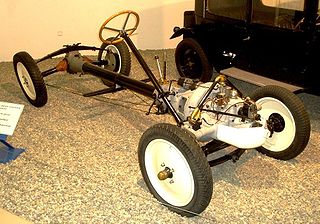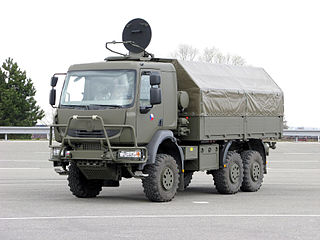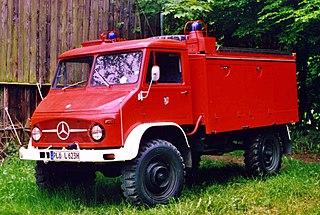
Tatra is a Czech vehicle manufacturer from Kopřivnice. It is owned by the TATRA TRUCKS a.s. company, and it is the third oldest company in the world producing motor vehicles with an unbroken history. The company was founded in 1850 as Ignatz Schustala & Cie. In 1890 the company became a joint-stock company and was renamed the Nesselsdorfer Wagenbau-Fabriksgesellschaft. In 1897, the Nesselsdorfer Wagenbau-Fabriksgesellschaft produced the Präsident, which was the first factory-produced automobile with a petrol engine to be made in Central and Eastern Europe. In 1918, the company was renamed Kopřivnická vozovka a.s., and in 1919 it changed from the Nesselsdorfer marque to the Tatra badge, named after the nearby Tatra Mountains on the Czechoslovak-Polish border.

The Tatra 815 is a truck family, produced by Czech company Tatra. It uses the traditional tatra concept of rigid backbone tube and swinging half-axles giving independent suspension. The vehicles are available in 4x4, 6x6, 8x8, 10x8, 10x10, 12x8 and 12x12 variants. There are both air-cooled and liquid-cooled engines available with power ranging from 230–440 kilowatts (310–590 hp). As a successor to Tatra 813 it was originally designed for extreme off-road conditions, while nowadays there are also variants designated for mixed use. The gross weight is up to 35,500 kg (78,264 lb).

Portal axles are an off-road vehicle suspension and drive technology where the axle tube or the half-shaft is off-set from – usually above – the center of the wheel hub and where driving power is transferred to each wheel via a simple gearbox, built onto each hub. This gives two advantages: ground clearance is increased, particularly beneath the low-slung differential housing of the main axles — and secondly, any hub reduction gearing allows the axle halfshafts to drive the same power but at reduced torque. This reduces load on the axle crownwheel and differential.

Backbone tube chassis is a type of automobile construction chassis that is similar to the body-on-frame design. Instead of a two-dimensional ladder-type structure, it consists of a strong tubular backbone that connects the front and rear suspension attachment areas. A body is then placed on this structure. It was first used in the English Rover 8hp of 1904 and then the French Simplicia automobile in 1909.

The TatraT813 was a truck produced in Czechoslovakia by the Tatra company. It was produced from 1967 to 1982. The basic representative of this series was a military version of the 8×8 Kolos (Colossus), which was able to pull trailers up to a total weight of 100 tons. Tatra also produced a civilian version in either 6×6 or 4×4. After fifteen years of production, 11,751 vehicles were built in all modifications. Many units were exported to the USSR, East Germany, Romania and India.

The Tatra 148 was a truck produced in Czechoslovakia by the Tatra company.

The Tatra T11 is an automobile that was produced from 1923 through 1927. It was the first Tatra model to use backbone tube chassis, swinging half-axles and air-cooled engine, the development of which is still in use on the trucks produced by Tatra to this day.

The Tatra 138 was a truck produced in Czechoslovakia by the Tatra company. The immediate successor to the Tatra 111, the model introduced a number of new features while continuing the evolution of Tatra concept. The truck was produced from 1959 to 1971.

FAP 2026 is a general purpose off-road lorry made by Serbian vehicle manufacturer Fabrika automobila Priboj (FAP). The six-wheel drive lorry is designed for transport of personnel, weapons and material up to 6 tons of total weight, as for traction of weapons and trailer up to 7.2 tons of weight for the needs of the Yugoslav People's Army.

The Tatra 54 is an automobile launched by Tatra in 1931. An economy version of the Tatra 52, it was replaced in 1933 by the Tatra 75.

The Tatra 12 is an automobile produced by Czech manufacturer Tatra between 1926 and 1933. It was replaced by the Tatra 57 in 1932.

The Tatra 26 is a vintage 6x4 automobile produced by the Czech manufacturer Tatra in the late 1920s and early 1930s. It was developed on the basis of the T 12. However, tests showed that the engine from T 12 did not have enough power, and it was replaced by the Tatra 30 engine. The car had extreme off-road abilities - reportedly it was even able to climb staircases.

The Tatra T 810 (Tactic) is a medium truck made by Czech company Tatra; it replaced the popular Praga V3S which was introduced in the 1950s and served in the Army of the Czech Republic until 2008. Unlike other Tatra trucks, it does not use classic Tatra air-cooled engine and the traditional Tatra conception of backbone chassis and swinging half-axles, but the customary truck architecture with conventional frame. It is mainly intended for difficult terrain conditions. The civilian version T 810-C was introduced in 2010.

The Tatra T816 is a truck family, produced by Czech company Tatra. It uses the traditional tatra concept of rigid backbone tube and swinging half-axles giving independent suspension. The vehicles are available in 4x4, 6x6, 8x8, 10x8, 10x10, 12x8 and 12x12 variants. The truck was developed from the model T815 to comply with the most demanding off-road conditions. Originally the T816 range was developed for the purposes of military, however today also civilian applications are available (notably as heavy off-road firefighting trucks.

The original Škoda Superb is a full size luxury car that was made by the Czechoslovak car manufacturer ASAP, later AZNP from 1934 to 1949. It was the company's first car with a V8 engine and all-wheel drive.

An H-drive drivetrain is a system used for heavy off-road vehicles with 6×6 or 8×8 drive to supply power to each wheel station.

The Praga V3S is an all-terrain multi-purpose truck, produced between 1953 and 1990 in Czechoslovakia. It was designed for the armed forces and was also exported to 72 countries. Praga produced the truck until 1964, then the Avia company till around 1986, after which the Bratislava company BAZ rolled out these vehicles till 1990. Around 130,000 units were manufactured. The truck was among the best off-road cargo vehicles of its time and the Czechoslovak Army used it for more than half a century. It was the longest produced Czechoslovak truck and it still serves in Czech Army for more than 70 years, despite being slowly replaced by Tatra 810 and Tatra 815.

The Volkswagen Typ 87, also known as the Kommandeurswagen, is a World War II, four-wheel-drive version of the Volkswagen Beetle. It was produced from 1941 to 1944 by the Volkswagen plant, primarily for high officers of the Wehrmacht. The Wehrmacht classified the Kommandeurswagen as leichter geländegängiger PKW, 4-sitziger, 4-radgetriebener Geländewagen Typ 87..

The Unimog 404, also called the Unimog S and Unimog 404 S, is a vehicle of the Unimog-series by Mercedes-Benz, produced in the Unimog plant in Gaggenau from 1955 to 1980. Marketed as Unimog U82, and later Unimog U110, 64,242 units of the two Unimog 404 types 404.0 and 404.1 were built, which makes the 404 the Unimog model with the highest production figure of all Unimogs. Unlike the Unimog 401, the 404 is rather a small 1.5-tonne-offroad-truck than an agricultural vehicle. In Germany, it was a common military vehicle and fire engine, 36,000 Unimog 404 were made for the Bundeswehr.

The SAMIL 50 is a 4x4 6-ton (load) truck.






















